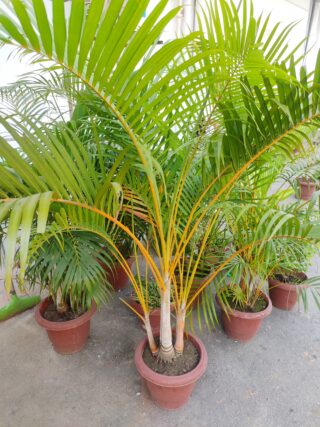How to Keep Your Majesty Palm Looking Majestic
When I was growing up, my sister and I would talk at length about where we hoped to travel one day. I’d constantly switch up my answers: Italy one day, Sweden the next; if I was feeling like I wanted to keep it just a bit more local, I’d name a national park. But my sister, her answer was always Madagascar—without fail.

Why Madagascar? I’d ask. What made a little girl dream of a place that seemed so far away? Well, she was fascinated by the “cool plants and animals” there—for which I now know the proper term, biodiversity.
Madagascar is brimming with incredible species, one of which is the majesty palm. Native to the riverbanks of Madagascar, the majesty palm (Ravenea rivularis) can grow up to 100 feet tall. Inside your home, though, it’ll keep to a nice 10 feet—if the conditions are right: bright light indoors, dappled light outdoors, and high humidity to thrive.
If you’re in for an adventure like my sister, a majesty palm is perfect for you—they do have a reputation for being a bit finicky. But it’s nothing you can’t handle with a little help! Here are some tips from our Plant Docs in the Mertz Library:
- Water: during the growing season, water your palm until water runs out of the bottom of the pot. Always remove the water in the run-off dish after 15 minutes or the delicate roots can easily rot. Allow the top inch or so of soil to dry before re-watering and never let the root ball become completely dry. During the winter, let your plant have a rest and reduce watering to suit the winter temperature of the room and the shorter days.
- Drainage: An essential part of palm care. A potted palm must be kept in a pot with a drain hole and should rest on one to three inches of small stones or pebbles in the base of the pot.
- Temperature: Keep between 65 and 75 degrees and do not subject the plant to temperature shocks from open windows, dramatic shifts in location, air conditioning or heating vents.
- Fertilizer: About two, summer-time, half-strength feedings with a palm-specific, slow-release food is adequate. Palms do not like the buildup of salt in the soil from too much fertilizer. Do not allow the soil to become compacted so that nutrition is restricted.
-
Light: Growing a palm plant indoors requires providing it with the bright but indirect sunlight of a lower canopy tree daily. A room with a bright southern or eastern exposure is usually most successful. Palms will tolerate poor light conditions but their health will slowly deteriorate.
One of the most common problems is yellowing leaves. There are several factors that can cause this. Take a look at your palm to determine what exactly could be the issue.
- If the entire leaf is mottled or streaky yellow and green, it is most likely to be caused by the roots getting dried out during the summer months.
- Brown or yellow leaf spots or splotches are often a signal that the plant is being over-watered, the soil is not draining well or a sign of sudden temperature change.
- If lower leaves are gradually turning yellow and then brown, that can be a natural aging process and these leaves may be trimmed off.
-
Leaf tips, particularly on young leaves, may be very sensitive and can turn brown if touched when brushing by the plant. Brown leaf tips also occur when humidity is lower than ideal and when fertilizer builds up in the soil.
You don’t have to travel anywhere to experience these amazing plants—you can grow them right inside your home! You can find additional information in our Guide to Palm Plants Indoors. Have more questions? Send them to our Plant Docs at plantinfo@nybg.org.
SUBSCRIBE
Enter your email address to subscribe to this blog and receive updates on new posts.











